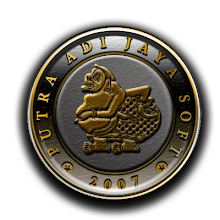Placing an icon the system tray
-------------------------------
NOTE: You can download the full source code of this article from
http://www.latiumsoftware.com/download/d00035.zip
The system tray is the area at the right of the task bar where "background" applications can place their icons. To place an icon in the tray you have to call the Shell_NotifyIcon API declared in the ShellAPI unit, passing it the constant NIM_ADD (to tell it to add an icon) and the address of a TNotifyIconData record with the icon information that includes the handle of the icon to show, the text to show as tool tip when the mouse is over the icon, the handle of the window that will receive the messages of the icon and the message type the icon will send to this window.
uses
..., ShellAPI;
const
WM_ICONTRAY = WM_USER + 1; // User-defined message
type
...
var
...
NotifyIconData : TNotifyIconData;
implementation
procedure TForm1.FormCreate(Sender: TObject);
begin
with NotifyIconData do begin
hIcon := Icon.Handle;
StrPCopy(szTip, Application.Title);
Wnd := Handle;
uCallbackMessage := WM_ICONTRAY;
uID := 1;
uFlags := NIF_MESSAGE + NIF_ICON + NIF_TIP;
cbSize := sizeof(TNotifyIconData);
end;
Shell_NotifyIcon(NIM_ADD, @NotifyIconData);
end;
Handling icon messages
----------------------
Form1 will receive WM_ICONTRAY messages from the icon. To capture and handle these messages we have to declare a new method in our form. For example:
type
TForm1 = class(TForm)
...
private
{ Private declarations }
...
procedure Icontray(var Msg: TMessage); message WM_ICONTRAY;
public
{ Public declarations }
...
end;
In the implementation of this method we can for example display a popup menu when the user right-clicks on the icon. Assuming you have created a popup menu named PopupMenu1, the following code will do the trick:
procedure TForm1.Icontray(var Msg: TMessage);
var
CursorPos : TPoint;
begin
if Msg.lParam = WM_RBUTTONDOWN then begin
GetCursorPos(CursorPos);
SetForegroundWindow(Handle); // suggested by Berend Radstaat
PopupMenu1.Popup(CursorPos.x, CursorPos.y);
PostMessage(Handle, WM_NULL, 0, 0); // suggested by Berend Radstaat
end else
inherited;
end;
Thanks to Berend Radstaat for the additions to this article.
Showing and hiding the form
---------------------------
Normally you will include a menu item in the popup menu to show the form, so all you have to do is write an event handler to call the Show method of the form and optionally remove the icon from the system tray:
procedure TForm1.mnuShowClick(Sender: TObject);
begin
Show;
// Shell_NotifyIcon(NIM_DELETE, @NotifyIconData);
end;
When the user closes the form, you can for example hide it instead of closing it and optionally show the icon again in the system tray if you have removed it when you made the form visible. For example:
procedure TForm1.FormClose(Sender: TObject; var Action: TCloseAction);
begin
Action := caNone;
Hide;
// Shell_NotifyIcon(NIM_ADD, @NotifyIconData);
end;
Finishing the application
-------------------------
You can have a menu item in the popup menu to exit the application. In this case you have to write an event handler for its click event to remove the icon and finish the application:
procedure TForm1.mnuExitClick(Sender: TObject);
begin
Shell_NotifyIcon(NIM_DELETE, @NotifyIconData);
Application.ProcessMessages;
Application.Terminate;
end;
skip to main |
skip to sidebar

Vb, Delphi, .net, framework, C++, Java, Pascal,Visual Studio, Asm, Ruby, C#, j#, Cs, Html, Php, Perl, Asp, xHtml Get Free Souce Code Here...
About Me

- Putra Adi Jaya Soft'
- Kami Berpengalaman Selama lebih dari 10 thn dalam IT, lebih dari 400 project dengan tema sistem informasi, GIS ,Penolahn citra digital, sistem pakar, kecerdasan buatan, networking, robotik, automatisasi, sistem remote dll, telah kami kerjakan. Baik program untuk usaha, edukasi, tugas akhir atau skripsi, kami memberikan solusi perancangan dan pembuatan program sesuai kebutuhan anda. Pembuatan program dari awal dan maintainance serta bimbingan (untuk project Tugas Akhir atau sejenisnya), pastinya dengan harga yang sangat terjangkau. Semoga kami dapat membantu anda. emoga kami dapat membantu anda.
Archive
-
▼
2008
(38)
-
▼
December
(38)
- How to use the keyboard as input for games - Delphi
- How to send keystrokes to another application (a b...
- Adding Application or Ports to the Windows Firewal...
- How to detect a program that Not Responding? - Delphi
- Execute screensaver, then force execute your appli...
- Send characters to another control (in any applica...
- How to find out if CAPS LOCK is on? b - Delphi
- Changing the screen resolution - Delphi
- Show Windows properties window - Delphi
- Accessing the Windows Registry - Delphi
- logged in as administator - Delphi
- How to set the current screensaver - Delphi
- Making an application run automatically when Windo...
- Hiding caption bars - Delphi
- Detecting CPU type - Delphi
- Changing hard drive's icon under Windows XP - Delphi
- Changing attributes of files - Delphi
- Get the next day of the month
- Make A System-Wide Shorcut Key !! - Delphi
- Preventing the user from closing a form - Delphi
- Display forms full screen
- Rotate an image by 90º
- Inserting a .bmp file into your .exe
- Screencapture with animated gif support!
- check, if a directory is empty - Delphi
- Show Windows properties window - Delphi
- Send a file to windows recycle bin - Delphi
- Searching for a directory
- Getting the icon of an application, library or doc...
- Minimize All Windows on Desktop - Delphi
- Determining if there is a disk/diskette/CD in a re...
- Starting an application as an icon in the system t...
- How to start the "Control Panel"
- Windows Search Engine - Delphi
- Multi-files properties dialog? - Delphi
- Transparent Desktop Icon - Delphi
- Theme application- Make a different style!
- How to make XP Style Buttons in your VB.Net
-
▼
December
(38)
0 comments:
Post a Comment